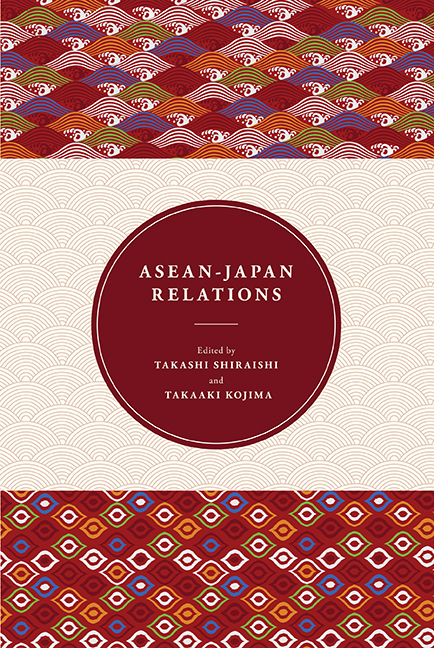Book contents
- Frontmatter
- Contents
- Preface
- About the Contributors
- 1 An Overview of Japan-ASEAN Relations
- 2 Japan's Relations with ASEAN
- 3 Approaches toward Regionalism: Japan, China and the Implications on ASEAN
- 4 The New Japan-ASEAN Partnership: Challenges in the Transformation of the Regional Context in East Asia
- 5 ASEAN-Japan Strategic Partnership and Regional Integration: Impacts and Implications
- 6 ASEAN-Japan Cooperation on Maritime Non-Traditional Security Issues: Toward a New Paradigm
- 7 Japan's Evolving Security Concerns in Maritime Southeast Asia: From Safety of Navigation to “Lake Beijing”
- 8 Evolution of Institutions and Policies for Economic Integration in East Asia: The Rise of China and Changes in the Regional Order
- 9 Managing Integration in East Asia: Behind Border Issues in Japan-ASEAN Trade Agreements
- 10 Regional Financial Cooperation in East Asia: Development and Challenges
- 11 Japanese Development Assistance to ASEAN Countries
- 12 Japanese Foreign Direct Investment in the ASEAN-4 Countries
- 13 Japan's Triple Tsunami
- 14 ASEAN-Japan Relations: A Singapore Perspective
10 - Regional Financial Cooperation in East Asia: Development and Challenges
Published online by Cambridge University Press: 21 October 2015
- Frontmatter
- Contents
- Preface
- About the Contributors
- 1 An Overview of Japan-ASEAN Relations
- 2 Japan's Relations with ASEAN
- 3 Approaches toward Regionalism: Japan, China and the Implications on ASEAN
- 4 The New Japan-ASEAN Partnership: Challenges in the Transformation of the Regional Context in East Asia
- 5 ASEAN-Japan Strategic Partnership and Regional Integration: Impacts and Implications
- 6 ASEAN-Japan Cooperation on Maritime Non-Traditional Security Issues: Toward a New Paradigm
- 7 Japan's Evolving Security Concerns in Maritime Southeast Asia: From Safety of Navigation to “Lake Beijing”
- 8 Evolution of Institutions and Policies for Economic Integration in East Asia: The Rise of China and Changes in the Regional Order
- 9 Managing Integration in East Asia: Behind Border Issues in Japan-ASEAN Trade Agreements
- 10 Regional Financial Cooperation in East Asia: Development and Challenges
- 11 Japanese Development Assistance to ASEAN Countries
- 12 Japanese Foreign Direct Investment in the ASEAN-4 Countries
- 13 Japan's Triple Tsunami
- 14 ASEAN-Japan Relations: A Singapore Perspective
Summary
DEVELOPMENT OF REGIONAL FINANCIAL COOPERATION IN EAST ASIA
East Asian Miracle and Asian Financial Crisis of 1997–98
In the late 20th century East Asian economies achieved rapid economic growth, a phenomenon that is often called the “East Asian Miracle”. According to the World Bank (1993), from 1965 to 1990 East Asian economies grew faster than economies in any other region of the world. Eight high-performing Asian economies — Japan, the Four Tigers (Hong Kong, South Korea, Taiwan, and Singapore), Indonesia, Malaysia, and Thailand — grew roughly three times as fast as Latin American and South Asian economies, and five times faster than Sub-Saharan African economies. An export-oriented policy and a strategy to attract foreign direct investment, accompanied by high savings and investment in physical and human capital, contributed to the development of export-oriented manufacturing industries that drove growth in these economies.
Under the sustained high growth, the financial sector liberalization of the 1990s, and a de facto U.S. dollar-pegged foreign exchange rate regime, the East Asian economies attracted large cross-border capital inflow. As nominal domestic interest rates were significantly higher than interest rates on the U.S. dollar, local banks (including non-banking financial institutions) and local corporates sought to take advantage of lower interest rates by taking U.S. dollar loans from foreign lenders. The foreign lenders viewed such lending as lucrative investment opportunities as they placed high confidence in these economies owing to their sustained growth.
But these economies were also subject to the accumulated risks emanating from the capital inflow, that is, heightened vulnerability to external shocks. First, such capital inflow took the form of short-term, unhedged U.S.-dollar-denominated bank loans to local banks, non-banking financial institutions, and corporates. Second, the borrowers were not only in export industries — which could generate foreign exchange income — but also in non-tradable sectors, even channeling those funds into asset markets such as equity and real estate. Third, the capital inflow took place against a background of a market infrastructure that had weak banking supervision and legal systems (e.g., bankruptcy laws), and there were concerns about the robustness of their statistics and transparency.
- Type
- Chapter
- Information
- ASEAN-Japan Relations , pp. 184 - 206Publisher: ISEAS–Yusof Ishak InstitutePrint publication year: 2013



